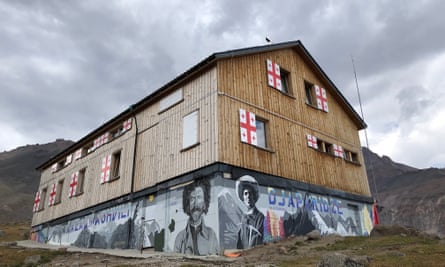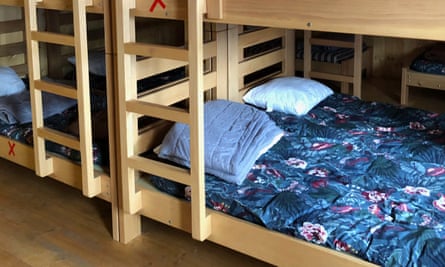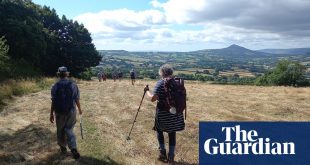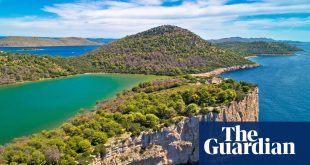Dawn comes at a little past 7am, when the early September sun pokes its head over the ridges east of the northern Georgian town of Stepantsminda, and paints the glaciers and knife edges of Mount Kazbek in hues of peach and magenta.
On the wooden deck where I stand, shivering, I alternate blowing the steam off a cup of coffee with struggling to capture the glorious light on my phone or in scribbles in a notebook.
Like thousands of climbers and hikers before me, I could have carried up a tent, along with food and stove, to pitch on the treeless alpine meadow in the shadow of Kazbek, a dormant stratovolcano that straddles the Georgia-Russia border. At 5,050 metres, it’s the third-highest mountain in Georgia. But I came to visit something new for Georgia, an alpine country not necessarily known for its alpine culture. A hut.
AltiHut is a 45-bed hostel at 3,014 metres that aims to offer hikers room and board while also striving to be a model for sustainable tourism – for this is a place where rubbish and human waste have long been an embarrassment. Its owners may be visionaries for Georgia’s potential as a hiking mecca. Or foolish entrepreneurs.

AltiHut is cosy and comfortable. There are several bunk rooms, with modern, well-insulated windows. Electricity comes from solar panels, and heat from a wood-burning stove in the dining room, where giant windows offer jaw-dropping views of Kasbek and its approaches, including the Gergeti glacier, a lumbering geological marvel that for aeons has been pulling the mountain down into rivers of silt, sand, pebbles and boulders, and is itself now succumbing to climate-change oblivion.
“Georgia has this incredible mountain culture, but we have no tradition of mountain huts,” says Nikoloz Alavidze, one of three principal partners in the hut venture. “It’s still a luxury for many Georgians.”
Nik and his partners conceived the idea after being dismayed at the amount of waste left behind by tourists climbing Kazbek. “It started with a toilet,” Nik says. “There’s years of garbage up there– Soviet garbage. Plus human waste, which is a problem, because at altitude it doesn’t decompose.”
The three started pitching ideas to the municipal authorities, proposing to put up high-altitude bio-toilets, but the officials only wanted to make a business out of it. Then they proposed building a proper hut to accommodate some of the foot traffic and also reduce alpine waste. They got permission from national authorities to acquire the land, which is in a protected area, and invested more than US$500,000 in site work and a geological survey.

While there are no showers at AltiHut, there is fully functional indoor plumbing for the toilets. David Chichinadze, another of the partner who opened AltiHut in 2018, says the sewage system is a big improvement on the open sewers and waste dumps that plague the mountain’s most popular camping spot: the old meteorological station a few kilometres higher.
The hut opened for business in November 2018, just as winter set in, and a group of Polish climbers were the first to stay. The following year, they had few customers – new operation, little marketing – and then in 2020 the pandemic hit. Four years later, however, increasing numbers of Georgians are aware of the hut, as are more foreign tourists. There are backcountry ski touring competitions, and an ultramarathon race was scheduled for the weekend. The rarely seen Güldenstädt’s redstart, which frequents the high ridges, is also attracting birdwatchers.

A half-board stay in peak winter season (Dec-May) costs about £95pp. So far, the clientele is mainly European, not Georgian. “It’s not affordability that’s the issue, but absence of mountaineering culture among the local population,” David says. “Most Georgians prefer not to spend their holidays actively, but rather at the seaside and in restaurants. However, we are now seeing a new generation of Georgians more interested in outdoor sports.”
Like at the German and Swiss huts that AltiHut is modelled on, no hiking boots are allowed inside, so visitors are offered Crocs to shuffle around in. Bedding is provided; laundry is done down in the village and transported up and down via horseback. (This is also an option for transport, if foot travel isn’t your thing.)
If there’s anything that’s underwhelming about Altihut, it’s the food. It is basic: cheese dumplings similar to Ukrainian vareniki served with butter, cabbage-and-beet soup. The best thing is the bread, baked daily. You’re hungry from the hike when you arrive, so this filling fare is welcome. But in Georgia, a country with superlative food culture, it’s a bit disappointing. Beer and wine are available at the hut, as are various spirits, including Georgia’s other national drink: chacha.
At the time of my visit the handful of other guests, included a trio of young Austrians, and a couple of late-arriving Turks who intended to summit Kazbek before daybreak.Like me, they had all made the four-hour climb to the hut from Stepantsminda, which sits astride the main highway from Georgia into Russia. Stepantsminda is a three-hour drive from the capital, Tbilisi, and is a mosh pit of tourist services, including cafes, guides and reasonable B&Bs where you can acclimatise to the altitude. Jeep drivers will lie to you about how hard a climb it is, in order to persuade you to drive with them. Ignore them: the hut, Mount Kazbek, the Gergeti glacier and the breathtaking alpine landscape are all reasons enough to make the trek.
And then there’s the 14th-century stonework masterpiece known as the Gergeti Trinity church, perched on a bluff above Stepantsminda, and well below AltiHut. Climbing up to the church, you can either hike along a valley stream, or beside the road. Either way, you have to wind through the back yards and drying laundry of the locals’ homes, most of whom depend on tourism for their livelihood. At a good clip, you can reach the church in 90 minutes – it’s a 500 metre climb through sandy scrub pines – and ponder what it was like for Orthodox monks, and their workers centuries earlier to build the structure using only horses and brute strength.
Gergeti is a fully working church and monastery. Its structure is a cross-in-square design, typical of late Byzantine architecture. The original wall paintings and murals have faded with age, but the iconostasis and the crackling of beeswax candles still lend an air of sanctity.

From the church, you climb up along a ridge that, in early September, passes through dry grasses and trees, and is a popular route for alpinists heading to the summit. While not technically challenging, the climb – about 800 metres from the church – takes some effort, particularly in the hot, late summer sun. The ridge approaches the AltiHut from the south-east, along a precipitous path with a sheer drop into a valley. When you stop, you can hear the roar of the river – thousands of years of glacial runoff – and even the faint call of hawks riding thermal updrafts.
 Top Naija News: Nigerian News, Breaking News Nigeria and World News Top Naija News is a daily news publication in Nigeria, delivering the latest breaking news in Nigeria and around the world.
Top Naija News: Nigerian News, Breaking News Nigeria and World News Top Naija News is a daily news publication in Nigeria, delivering the latest breaking news in Nigeria and around the world.



